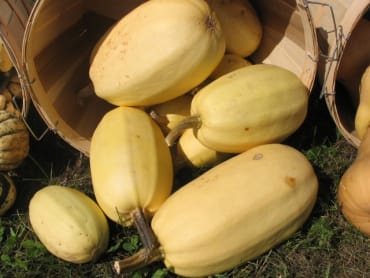(88 days) Open-pollinated. Oblong fruits, generally around 4 lb with spaghetti-like strings in the flesh. Penny Kupinski of Harrisburg, MO, took us to task for damning spaghetti squash with faint praise. “From your description you may not have had truly ripe spaghetti squash which is a deep gold. Pale yellow is nowhere near ripe and tasteless and tough. Takes a long time to mature even here…but has a wonderful nutty flavor when ripe and needs only a little salt and pepper to be excellent…It is also a great keeper.” Plenty of customers agree with her—we now sell more than 50 lbs of seed each year. First commercialized by Sakata in Japan in 1934 and brought to the States by Burpee two years later. ⑤
Spaghetti
Spaghetti
(88 days) Open-pollinated. Oblong fruits, generally around 4 lb with spaghetti-like strings in the flesh. Penny Kupinski of Harrisburg, MO, took us to task for damning spaghetti squash with faint praise. “From your description you may not have had truly ripe spaghetti squash which is a deep gold. Pale yellow is nowhere near ripe and tasteless and tough. Takes a long time to mature even here…but has a wonderful nutty flavor when ripe and needs only a little salt and pepper to be excellent…It is also a great keeper.” Plenty of customers agree with her—we now sell more than 50 lbs of seed each year. First commercialized by Sakata in Japan in 1934 and brought to the States by Burpee two years later. ⑤
Additional Information
Spaghetti group
About 190 seeds/oz. ⅛ oz packet sows 10 hills.
Cucurbita pepo
One of the oldest domesticated species. Pepo derives from the Greek pepon, meaning ‘ripened by the sun.’ They have hard 5-sided ribbed stems, and fruits are usually ribbed. They also include summer squashes and small gourds, as well as some pumpkins.
Winter Squash
- All open-pollinated except where noted.
- Days to maturity are from direct seeding; subtract 20 days for transplants.
Culture: May be direct-seeded or transplanted. Minimum germination temperature 60°, optimal temperature range 70–90°. Direct seeding: Sow 4–5 seeds per hill when weather has warmed after danger of frost. Allow 4–6' between hills. Thin to 3 best plants. Transplanting: Start indoors three weeks before setting out. Do not disturb the roots. Transplant bush varieties 18" apart, vining varieties 30" apart. For either method, use wire hoops and row covers to hasten maturity and reduce insect damage. Tender, not frost hardy. Heavy nitrogen feeders. Excessive heat and/or drought can prevent blossom set, reduce yields. Winter squash can take one or two light frosts on the vine. To improve flavor and storage, field cure for at least 10 days after harvest, covering if hard frost threatens. Store under proper conditions, at least 50° and 60–70% relative humidity in a place with good air circulation. Do not pile up squash. Inspect periodically and be sure to use damaged, stemless or small fruit first. Acorns have the shortest storage time before getting stringy, followed by delicatas, buttercup/kabochas.
Saving Seed: Saving squash seed is challenging! We list three species of the genus Cucurbita: C. pepo, C. maxima and C. moschata. Varieties of the same species will cross readily, but crossing will not occur between the different species. You must isolate varieties of the same species by half a mile if you want true-to-type seed. This is difficult for most gardeners—you may have to communicate and collaborate with neighboring gardeners, or exclude insects from blossoms and hand-pollinate. If you can pull off the variety isolation, processing the seeds is easy: rinse seeds from the guts of fully ripe and cured squash. Dry and store.
Diseases: BR: Black Rot, PM: Powdery Mildew
Pest: Striped Cucumber Beetle
Cultural controls: use tolerant or resistant varieties, rotate crops, till under crop debris soon after harvest, use floating row covers until flowers appear, use plastic mulch, perimeter trap cropping (Black Zucchini and Blue Hubbard make particularly good trap crops), use yellow sticky strips, hand-pick early morning when beetles are very sluggish.
Materials: Surround, Pyrethrum (PyGanic).
Pest: Squash Bug
Cultural controls: rotation, till in cucurbit debris before winter and plant a cover crop, boards on soil surface near squash will attract bugs overnight which can be killed, avoid mulching. Squash bugs lay their brown-brick red egg clusters on the underside of the foliage, often next to the central vein—destroy egg clusters on undersides of leaves.
Materials: Pyrethrum on young nymphs, AzaMax.
Pest: Squash Vine Borer
Cultural controls: butternut squash is resistant, maximas & pepos susceptible; rotation, plow in squash vine debris soon after harvest, use floating row covers, watch for wilting plant parts and destroy borer within.
Disease: Powdery Mildew
Controls: Use small plots to slow spread, plant indeterminate (viney) varieties, control weed competition.
Materials: sulfur and whole milk, mineral or other oils in combination with potassium bicarbonate.
Disease: Bacterial Wilt
Cultural control: Striped Cucumber Beetle is vector—control it; choose resistant varieties.
Germination Testing
For the latest results of our germination tests, please see the germination page.
Our Seeds are Non-GMO

All of our seeds are non-GMO, and free of neonicotinoids and fungicides. Fedco is one of the original companies to sign the Safe Seed Pledge.


